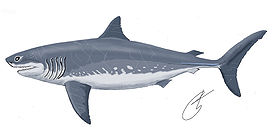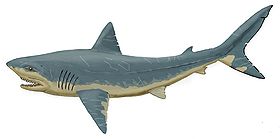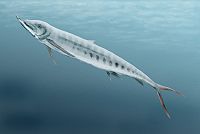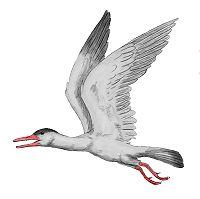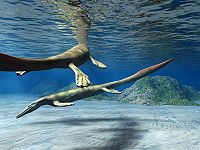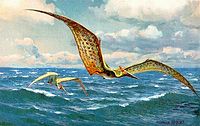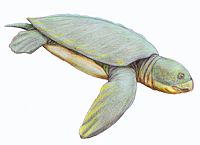- Mooreville Chalk Formation
-
Mooreville Chalk Formation
Stratigraphic range: Upper CretaceousType Geological formation Unit of Selma Group Sub-units Arcola Limestone Member Underlies Demopolis Chalk Formation Overlies Eutaw Formation Lithology Primary Chalk Location Region Alabama, Mississippi Country  United States
United StatesThe Mooreville Chalk Formation is a geological formation in North America, within the U.S. states of Alabama and Mississippi. The strata date back to the early Santonian to the early Campanian stage of the Late Cretaceous.[1] The chalk was formed by pelagic sediments deposited along the eastern edge of the Mississippi embayment. It is a unit of the Selma Group and consists of the upper Arcola Limestone Member and an unnamed lower member.[2] Dinosaur, mosasaur, and primitive bird remains are among the fossils that have been recovered from the Mooreville Chalk Formation.[1][2][3]
Contents
Fish
Cartilaginous fish
Cartilaginous fish of the Mooreville Chalk Formation Genus Species Location Stratigraphic position Abundance Notes Images Cretalamna
C. appendiculata[3]
C. mantelli[3]
E. barberi[4]
E. mirificus[4]
I. williamsae[4]
O. cuspidata
Propenser
P. hewletti[4]
P. mammillaris[4]
P. mortoni[3]
P. polygyrus[4]
Pseudocorax
P. affinis[4]
P. laevis[3]
Serratolamna
S. serrata[3]
S. rhaphiodon[4]
S. texanus[3]
S. falcatus[4]
S. kaupi[3]
Bony fish
Bony fish of the Mooreville Chalk Formation Genus Species Location Stratigraphic position Abundance Notes Images Albula
A. dunklei[4]
An albuliform
B. crieleyi[4]
A tselfatiform
C. nepaholica[4]
E. petrosus[4]
E. saevus[4]
Hoplopteryx sp.[4]
I. ctenodon[4]
An ichthyodectiform
M. hardi[4]
An elopiform
P. caninus[4]
An elopiform
S. leanus[4]
An ichthyodectiform
S. apicalis[4]
X. audax[4]
An ichthyodectiform
Reptiles
Dinosaurs
Indeterminate hadrosaurid, nodosaurid, dinosaur egg, and ornithomimmosaur fossils are known from Moorville Chalk outcrops in Alabama.[1]
Color key
Taxon Reclassified taxon Taxon falsely reported as present Discredited taxon Ichnotaxon Ootaxon Morphotaxon Notes
Uncertain or tentative data are in small text;crossed outdata are discredited.Dinosaurs reported from the Mooreville Chalk Formation Genus Species Location Stratigraphic position Material Notes Images Angelinornis
A. antecessor
A. antecessor was originally described as Plegadornis antecessor, but the generic name Plegadornis was preoccupied, so the genus Angelinornis was erected to contain the species. It was later demonstrated that Angelinornis was a junior synonym of Ichthyornis, although the new combination I. antecessor was held to be valid for a while following the sinking of Angelinornis into Ichthtyornis. Later the species would later be considered a junior synonym of the Ichthyornis type species, I. dispar.[1]
"Vertebrae and limb elements."[5]
An enantiornithine
I. antecessor
The species I. antecessor was erected after the genus previously containing the species, Angelinornis, was shown to be a junior synonym for Ichthyornis. Later I. antecessor itself was shown to be a junior synonym of the Ichthyornis type species, I. dispar[1]
An ichthyornithine.
Plegadornis
P. antecessor
The name Plegadornis antecessor was applied to a fossil believed to represent a new bird species, but the generic name Plegadornis was preoccupied, so the genus Angelinornis was erected to contain the "new" species. It was later demonstrated that Angelinornis was a junior synonym of Ichthyornis, although the new combination I. antecessor was held to be valid for a while following the sinking of Angelinornis into Ichthtyornis. Later the species would later be considered a junior synonym of the Ichthyornis type species, I. dispar.[1]
Mosasaurs
Mosasaurs of the Mooreville Chalk Formation Genus Species Location Stratigraphic position Abundance Notes Images C. liodontus[4]
Mosasaurines
C. moorevillensis[3]
C. propython[4]
A halisaurine E. sternbergii was formerly classified as Halisaurus sternbergii
G. alabamaensis[3]
A mosasaurine
M. missouriensis[3]
A mosasaurine
P. tympaniticus[3]
A plioplatecarpine
P. rapax[4]
Mosasaurines
P. solvayi[3]
S. russelli[3]
A plioplatecarpine
T. proriger[4]
Mosasaurines
T. zangerli [3]
Plesiosaurs
Plesiosaurs of the Mooreville Chalk Formation Genus Species Location Stratigraphic position Abundance Notes Images Trinacromerum sp.[3]
Polycotylids
Pterosaurs
Pterosaurs of the Mooreville Chalk Formation Genus Species Location Stratigraphic position Abundance Notes Images Pteranodon sp.[3]
Turtles
Turtles of the Mooreville Chalk Formation Genus Species Location Stratigraphic position Abundance Notes Images Bothremys
B. barberi[3]
A pelomedusid.
C. haliniches
A dermochelyid.
P. gigas[3]
A protostegid.
T. moorevillensis[3]
A toxochelyid.
See also
References
- ^ a b c d e f g h i j k l m n o p Weishampel, David B; et al. (2004). "Dinosaur distribution (Late Cretaceous, North America)." In: Weishampel, David B.; Dodson, Peter; and Osmólska, Halszka (eds.): The Dinosauria, 2nd, Berkeley: University of California Press. Pp. 574-588. ISBN 0-520-24209-2.
- ^ a b c d e f Chiappe, Luis; Lamb, James P.; Ericson, PER G. P. (2002). "New enantiornithine bird from the marine Upper Cretaceous of Alabama". Journal of Vertebrate Paleontology 22 (1): 170–174. doi:10.1671/0272-4634(2002)022[0170:NEBFTM]2.0.CO;2. http://www.bioone.org/doi/full/10.1671/0272-4634(2002)022%5B0170%3ANEBFTM%5D2.0.CO%3B2. Retrieved 2009-02-07.
- ^ a b c d e f g h i j k l m n o p q r s t u v w Kiernan, Caitlin R. (2002). "Stratigraphic distribution and habitat segregation of mosasaurs in the Upper Cretaceous of western and central Alabama, with an historical review of Alabama mosasaur discoveries". Journal of Vertebrate Paleontology 22 (1): 91–103. doi:10.1671/0272-4634(2002)022[0091:SDAHSO]2.0.CO;2. http://www.bioone.org/doi/full/10.1671/0272-4634(2002)022%5B0091%3ASDAHSO%5D2.0.CO%3B2. Retrieved 2009-02-02.
- ^ a b c d e f g h i j k l m n o p q r s t u v w x y Applegate, Shelton P.; Dale E. Russell (1970). The Vertebrate Fauna of the Selma Formation of Alabama. Part VII. Part VIII. The Mosasaurs The Fishes. Chicago: Field Museum of Natural History. pp. 387–430. OCLC 50419737. http://www.archive.org/stream/vertebratefaunao38appl/vertebratefaunao38appl_djvu.txt.
- ^ "Table 11.1," in Weishampel, et al. (2004). Page 213.
- ^ Bardet N; Suberbiola P; Iarochene M; Bouyahyaoui F; Bouya B; Amaghzaz M (2002). "A new species of Halisaurus from the Late Cretaceous phosphates of Morocco, and the phylogenetical relationships of the Halisaurinae (Squamata: Mosasauridae)". Zoological Journal of the Linnean Society 143: 447–472. doi:10.1111/j.1096-3642.2005.00152.x. http://www.ingentaconnect.com/content/bsc/zoj/2005/00000143/00000003/art00005. Retrieved 2009-02-10.
Categories:- Geologic formations of the United States
- Cretaceous paleontological sites of North America
- Geology of Alabama
- Geology of Mississippi
- Chalk
Wikimedia Foundation. 2010.

